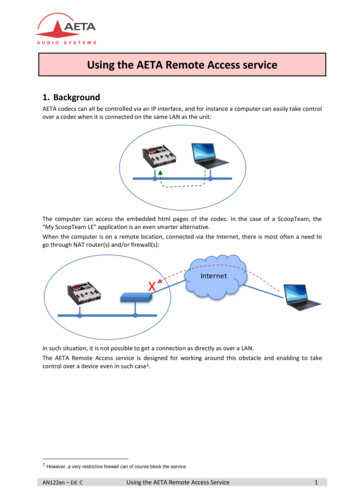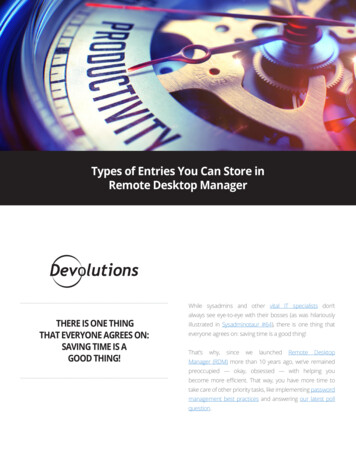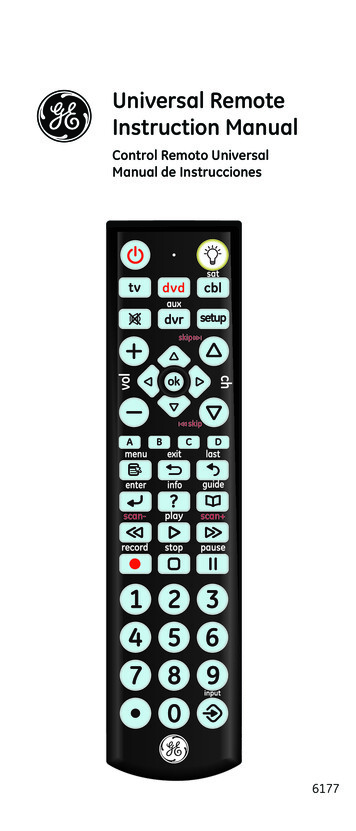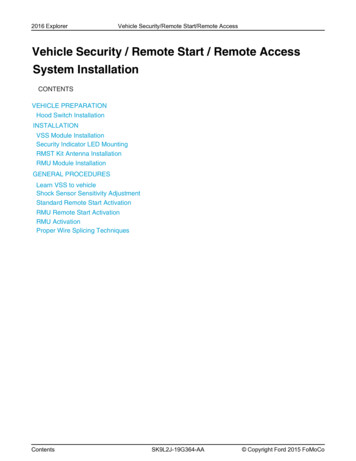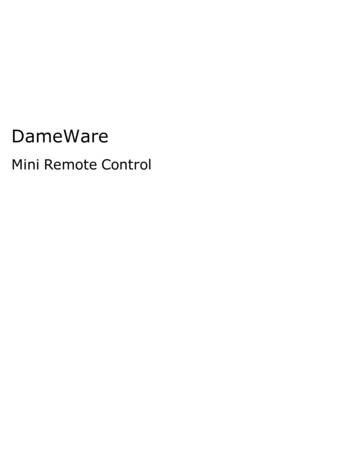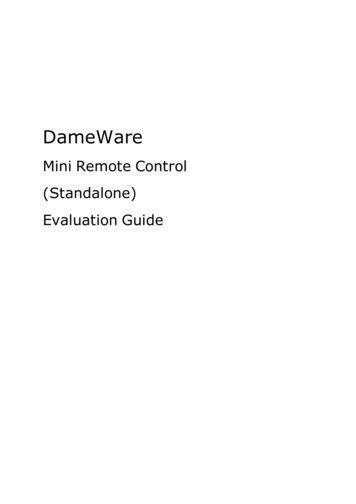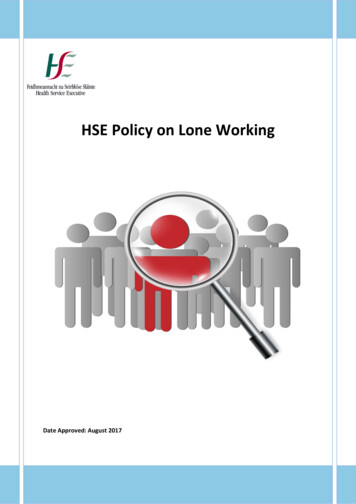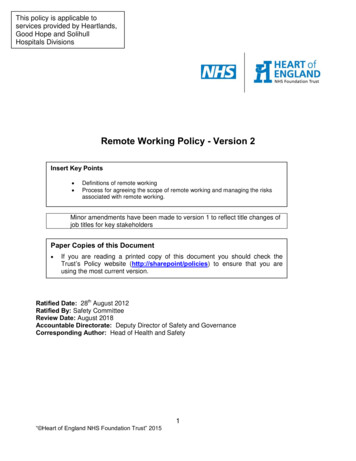
Transcription
This policy is applicable toservices provided by Heartlands,Good Hope and SolihullHospitals DivisionsRemote Working Policy - Version 2Insert Key Points Definitions of remote workingProcess for agreeing the scope of remote working and managing the risksassociated with remote working.Minor amendments have been made to version 1 to reflect title changes ofjob titles for key stakeholdersPaper Copies of this Document If you are reading a printed copy of this document you should check theTrust’s Policy website (http://sharepoint/policies) to ensure that you areusing the most current version.Ratified Date: 28th August 2012Ratified By: Safety CommitteeReview Date: August 2018Accountable Directorate: Deputy Director of Safety and GovernanceCorresponding Author: Head of Health and Safety1“ Heart of England NHS Foundation Trust” 2015
Meta DataDocument Title:Remote working policy Version 2StatusActiveDocument Author:Source Directorate:Date Of Release:Ratification DateRatified by:Review Date:Related documentsHead of health and SafetySafety and Governance1st August 201528th August 2012Safety CommitteeAugust 2018Lone Worker PolicyViolence and Aggression PolicyRisk Management PolicyDisplay Screen Equipment PolicyHealth and Safety PolicySupersededdocumentsRelevant ExternalStandards/ LegislationKey WordsRemote Worker Policy ratified in August 2012Health and Safety at Work etc. Act 1974Management of Health and Safety at Work Regulations 1999Remote workingRevision HistoryVersion StatusDateConsulteeCommentsGeneral Managers,OperationsManagers, Heads ofDepartment, Directorof Safety andGovernance andteams1 (new) DraftJuly121 (new)August Safety Committee122August Deputy Director15of Safety andGovernance(Acting)The policy was approved atthe meeting held on 28thAugust 2012.Minor title changes. Mainbody of the policy has notchanged2“ Heart of England NHS Foundation Trust” 2015Action fromComment
List of Contents1. Circulation.42. Scope.43. Definitions.44. Reason for Development.55. Aim.56. Standards.57. Responsibilities.68. Training requirements.89. Monitoring and compliance.810. References.911. Attachments/appendices.9 Attachment 1 Consultation and Ratification.10 Attachment 2 Equality and diversity Checklist.11 Attachment 3 Launch and Implementation Plan.14 Appendix 1 Hazards identification check list.15 Appendix 2 Remote working safety check list.203“ Heart of England NHS Foundation Trust” 2015
1.CirculationThis policy should be read by any member of staff that is employed by Heart of England NHSFoundation Trust who works away from their identified work base. The work base will usually be anidentified acute site, identified office block, or community clinic.2.ScopeThe policy applies to any member of staff that has authorisation to work as a remote worker as partof their contractual agreement, this will include: working across sites using “hot desk facilities” (unless specified site office accommodation isidentified as alternative bases) authorised working from home facilitating campaigns in non-healthcare settings providing screening services in non-healthcare settingsExcludes:This policy will not apply to personnel that are employed as dedicated community workers whoroutinely visit patient’s homes, work in identified healthcare settings such as G.P. surgeries, orsexual health outreach settings. These staff groups will include: district nurses community midwives health visitors school nurses Sexual health outreach practitionersAlthough the full application of this policy may not be appropriate for the services detailed above, thelone worker and violence and aggression policy must be adhered to. In addition managers of theseservices will also be required to ensure that detailed risk assessments have been completed andthat the risks are managed so far as is reasonably practicable.3.DefinitionsRemote working can be used to describe an employee who works away from their identifiedcontracted work base. Common terms used for remote working include: Home working – where the employee works mainly in their own home, or uses their home asa base when they work in different places. Included as part of their contractual agreement. Mobile working – working from any location, or in transit Agile working – dividing time between the main site and other locations other than theircontracted place of work Teleworking or telecommuting – working in a location that is separate from a central workplace, by using telecommunication technologies.4“ Heart of England NHS Foundation Trust” 2015
4.Reason for developmentRemote working is recognised as being a valuable mode of working in complex multi-site basedorganisations. It brings benefits to both the employer and employee because of the flexibility that itprovides. It should also be recognised that in addition to the benefits, remote working can alsointroduce risks that will need to be managed these will include: working in isolation risk to personal security risk of damage/theft of the organisations equipment data protection risks a temptation to utilise work areas that are not conducive and do not meet the requirements ofhealth and safety legislation, particularly in relation to the use of display screen equipment A lack of clarity on working times/home life balance Increased complexity for supervisionThis policy has been developed to incorporate legislative requirements and best practice guidancefor this specialised field of working to enable recognised risks both to the employee and theorganisation to be managed and the benefits of remote working to be optimised. It also aims topromote a cohesive framework that is in line with the broader risk management arrangements of theTrust.5.AimThe policy aims to provide a framework to ensure the safety of personnel who are working remotelyand also protect the security of personnel, information and trust assets. It will also aim to ensurethat employees are utilising resources (including time) appropriately and effectively6.StandardsThe stages below outline the standards that must be observed for remote working:Step 1 – the need for remote working is identified: Consider the benefits to the organisation and the employeeUsing the checklist provided in appendix 1 consider the hazards/risks associated with remoteworking. Detailed risk assessments will need to be completed for hazards/risks that cannotbe addressed locally and be managed in line with the trust Risk Management Policy.If remote working risks can be managed to an acceptable level proceed to step 2.Step 2 – agree the scope of remote working this will include (but is not exhaustive) cleardefinitions on: The locations that remote working will be permitted from, this should include details ofidentified office/hot desk facilities available from each base The individuals working hours. (clearly identifying the actual hours to be worked) Equipment that is authorised for use to include:- ICT equipment, mobile phones, clinicalequipment, general work equipment (to include any reasonable adjustments for disabledstaff) Arrangements for the transportation and storage of equipment5“ Heart of England NHS Foundation Trust” 2015
Authorised mode of transport to be used between locations i.e. public transport, trust vehicle,private vehicleAgreed method of contact/communication with base, to include the frequency that thecontact is requiredStep 3 – provision of training/awareness - due to the fact that remote workers can be isolatedfrom their main work base it is important they may require additional training and information toinclude: Lone working arrangementsInformation on local environmental safety issues and contacts to local emergency servicesRisk assessments relevant to their working activities, this should also include details of riskmanagement controls that must be adhered toSignposting to relevant policies and proceduresJob specific trainingAccess to HEFT intranet from remote locationStep 4 – Review Remote working practices should be reviewed at regular intervals the reviewshould include: The frequency of reviewA review of all relevant risk assessments and the initial checklist to ensure that they remainvalid and if the risk management controls that were put in place have been sustainedA review of incidents (to include any lessons learned from previous incidents)A wellbeing review for the remote worker (this may include a buddy scheme)A productivity review (to include work/life balance)7.Responsibilities7.1Individual ResponsibilitiesChief ExecutiveThe Chief Executive has overall accountability for the Safety and Governance framework at Heart ofEngland NHS Foundation Trust. The Chief Executive has delegated responsibility to the Director ofSafety and Governance.Director of Nursing (Chief Nurse)The Director of Nursing (Chief Nurse) has lead responsibility for health and safety and will: Ensure integration of health and safety plans into the Safety and Governance DirectorateStrategic business plans. Inform the Chief Executive of significant risks in relation to health and safety. Promote a positive safety culture to continually improve safe working practices6“ Heart of England NHS Foundation Trust” 2015
Ensure the Trust has an appropriate health and safety infrastructure and framework in place.Ensure appropriate provision of health and safety training. Advise the Trust Board and Governance and Risk Committee on health and safety matters.Deputy Director of Safety and GovernanceThe Deputy Director of Safety and Governance has delegated responsibility for clinical safety issuesand will: Support the Director of Nursing (Chief Nurse) to implement agreed Health and Safety Plans. Take lead responsibility for the management of Serious Clinical Incidents. Act as safety ambassador for patient safetyHealth and Safety/Local Security Management TeamThe health and safety team have responsibility for delivering the organisations health and safetyplan and will: Provide advice and support to managers enable them to maintain a safe workingenvironmentDeliver the health and safety training programme Monitor the implementation of this policyGeneral Managers, Heads of Department and MatronsGeneral Managers Heads of Department and Matrons are responsible for the day to daymanagement of their areas of responsibility and will: Have responsibility for ensuring that the remote working procedure identified in appendix 2 isadhered to Provide adequate resources to manage hazards and risks associated with remote working Agree local arrangements for monitoring compliance with the remote working procedures Escalate safety or operational concerns to the Operations Director7“ Heart of England NHS Foundation Trust” 2015
Individual Staff ResponsibilitiesIndividual members have staff have a duty to: 7.2Adhere to policies and procedures that are in placeReport hazards, risks to their line managerEscalate safety concerns to their line managerAttend training as requiredBoard and Committee ResponsibilitiesRatifying Board and Committee ResponsibilitiesSafety Committee will be responsible for ratifying this policyOperational CommitteesRisks identified as a result of implementing the procedures attached to this policy will be managedthrough the embedded risk management structures. The relevant operational committee will beidentified as part of that process.8.Training RequirementsTraining for remote workers will be determined by their individual circumstance and the work activitythat will be undertaken.9.Monitoring and sponsibleCommitteeHealth and SafetyTeamSafety CommitteeAn audit of the policy toinclude: How the need forremote working hasbeen identifiedClear agreement ofthe scope of the loneworking Training andawareness providedfor the lone workerUndertake periodicaudits to include:A review of thechecklists and riskassessments.Discussions withmanagersArrangements forreviewing the loneworking activities8“ Heart of England NHS Foundation Trust” 2015
10. References1 Health and Safety at Work etc. Act (HSE 1974)2 Health and Safety at Work Regulations (HSE 1999)3 Display Screen Equipment Regulations (HSE 1992)411.Personnel Security in Remote Working (CPNI February 2012)Attachments/AppendicesAdd attachments starting a new page for each attachmentThe following attachments must be included:Attachment 1Ratification ChecklistAttachment 2Equality Impact Assessment (EIA)Attachment 3Launch and Implementation PlanAppendix 1Remote worker hazard checklistAppendix 2Remote worker procedure safety checklist9“ Heart of England NHS Foundation Trust” 2015
Policies and Procedures Framework v4.0Attachment 1: Consultation and Ratification ChecklistTitleRemote Working PolicyRatification checklist1Is this a: Policy2Is this:DetailsactiveFormat matches Policies and Procedures Template (Organisation-wide)3Consultation with range of internal /external groups/ individuals4Equality Impact Assessment completed57Are there any educational or training implications?891011121314151617YesYesAre there any governance or risk implications? (e.g. patient safety, clinicaleffectiveness, compliance with or deviation from National guidance orlegislation etc)Are there any operational implications?6YesNoNoNoAre there any clinical implications?NoAre there any nursing implications?NoDoes the document have financial implications?NoDoes the document have HR implications?NoIs there a launch/communication/implementation plan within the document?YesIs there a monitoring plan within the document?YesDoes the document have a review date in line with the Policies and ProceduresFramework?Is there a named Director responsible for review of the document?YesIs there a named committee with clearly stated responsibility for approvalmonitoring and review of the document?YesYesDocument Author / SponsorRatified by (Chair of Committee or Executive Lead)SignedSignedTitleTitleDateDate Heart of England NHS Foundation TrustView/Print date 14 March 2018Page 10 of 21
Policies and Procedures Framework v4.0Attachment 2: Equality and Diversity - Policy Screening ChecklistPolicy/Service Title: Remote Working PolicyDirectorate: Director of Nursing (ChiefNurse)Name of person/s auditing/developing/authoring a policy/service: Health and Safety TeamAims/Objectives of policy/service: to define a systematic approach and required standards for thedevelopment, ratification, implementation, monitoring, review and retirement of Policies and associatedProcedures.Policy Content: For each of the following check the policy/service is sensitive to people of different age, ethnicity, gender,disability, religion or belief, and sexual orientation? The checklists below will help you to see any strengths and/or highlight improvements required to ensure thatthe policy/service is compliant with equality legislation.1. Check for DIRECT discrimination against any group of SERVICE USERS:Question: Does your policy/service contain anystatements/functions which may exclude peoplefrom using the services who otherwise meet thecriteria under the grounds of:1.1Age?1.2Gender (Male, Female and Transsexual)?1.3Disability?1.4Race or Ethnicity?1.5Religious, Spiritual belief (including other belief)?1.6Sexual Orientation?1.7Human Rights: Freedom of dNoYesNoResourceimplicationYesNonononononononoIf yes is answered to any of the above items the policy/service may be considered discriminatory andrequires review and further work to ensure compliance with legislation.2. Check for INDIRECT discrimination against any group of SERVICE USERS:Question: Does your policy/service contain anystatements/functions which may exclude employeesfrom operating the under the grounds of:2.1Age?2.2Gender (Male, Female and Transsexual)?2.3Disability?2.4Race or Ethnicity?2.5Religious, Spiritual belief (including other belief)?2.6Sexual Orientation? Heart of England NHS Foundation cationYesnonononononoView/Print date 14 March 2018Page 11 of 21No
Policies and Procedures Framework v4.02.7noHuman Rights: Freedom of Information/DataProtectionIf yes is answered to any of the above items the policy/service may be considered discriminatory andrequires review and further work to ensure compliance with legislation.TOTAL NUMBER OF ITEMS ANSWERED ‘YES’ INDICATING DIRECT DISCRIMINATION 3. Check for DIRECT discrimination against any group relating to EMPLOYEES:Question: Does your policy/service contain anyconditions or requirements which are appliedequally to everyone, but disadvantage particularpersons’ because they cannot comply due to:3.1Age?3.2Gender (Male, Female and Transsexual)?3.3Disability?3.4Race or Ethnicity?3.5Religious, Spiritual belief (including other belief)?3.6Sexual Orientation?3.7Human Rights: Freedom of dNoYesResourceimplicationNoYesNonononononononoIf yes is answered to any of the above items the policy/service may be considered discriminatory andrequires review and further work to ensure compliance with legislation.4. Check for INDIRECT discrimination against any group relating to EMPLOYEES:Question: Does your policy/service contain anystatements which may exclude employees fromoperating the under the grounds of:4.1Age?4.2Gender (Male, Female and Transsexual)?4.3Disability?4.4Race or Ethnicity?4.5Religious, Spiritual belief (including other belief)?4.6Sexual Orientation?4.7Human Rights: Freedom of dNoYesResourceimplicationNoYesNonononononononoIf yes is answered to any of the above items the policy/service may be considered discriminatory andrequires review and further work to ensure compliance with legislation.TOTAL NUMBER OF ITEMS ANSWERED ‘YES’ INDICATING INDIRECT DISCRIMINATION 0Signatures of authors / auditors: Heart of England NHS Foundation TrustDate of signing:View/Print date 14 March 2018Page 12 of 21
Policies and Procedures Framework v4.0Equality Action Plan/ReportDirectorate:Service/Policy:Responsible Manager:Name of Person Developing the Action Plan:Consultation Group(s):Review Date:The above service/policy has been reviewed and the following actions identified and prioritised.All identified actions must be completed by:Action:Rewriting policies or proceduresLead:Timescale:Stopping or introducing a new policy or serviceImprove /increased consultationA different approach to how that service ismanaged or deliveredIncrease in partnership workingMonitoringTraining/Awareness Raising/LearningPositive actionReviewing supplier profiles/procurementarrangementsA rethink as to how things are publicisedReview date of policy/service and EIA: thisinformation will form part of the GovernancePerformance ReviewsIf risk identified, add to risk register. Complete anIncident Form where appropriate.When completed please return this action plan to the Trust Equality and Diversity Lead;Pamela Chandler or Jane Turvey. The plan will form part of the quarterly GovernancePerformance Reviews.Signed by Responsible Manager: Heart of England NHS Foundation TrustDate:View/Print date 14 March 2018Page 13 of 21
Policies and Procedures Framework v4.0Attachment 3: Launch and Implementation PlanTo be completed and attached to any document which guides practice when submitted to theappropriate committee for consideration and approval.ActionWhoWhenIdentify key users / policywritersHealth andSafety teamDuringUtilise knowledge of servicesdevelopment within the trustPresent Policy to key usergroupsHealth andsafety teamDuringscheduledtrainingprogramme.Include awareness of policyduring health and safety trainingAdd to Policies andSandraProcedures intranet page / Greenwaydocument managementsystem.AfterratificationInclude on share point systemOffer awareness training /incorporate within existingtraining programmesHealth andsafety teamDuringscheduledtrainingprogrammeInclude awareness of policyduring health and safety trainingCirculation ionInclude on share point Heart of England NHS Foundation TrustHowInclude policy in safetycampaignsInclude policy in safetycampaignsView/Print date 14 March 2018Page 14 of 21
Policies and Procedures Framework v4.0Appendix 1Remote Working Hazards Identification Check ListThis checklist has been designed to assist managers and remote workers to identify hazards associated with remote working activities. Itshould be completed if the need for remote working is being considered.Site baseName/Job title of persons completing the checklist1.2.3.Description of remote working activity:Ward/Department BaseDatePeople involved or who may be affected by the work activityWorking in isolation/lone workingPromptsAction required or confirm risk managementcontrols that are in placeWill there be more than one person carrying outthe work activities at all times?If the activity will be carried out by one person a lone workerassessment must be carried outHow will the remote workers communicate with thebase and how frequentlyWhat time of day will the work activity take place?There may be increased hazards associated withworking unsocial hours which need to beconsideredWhat training/experience/skills/knowledge havethe remote workers received and how will theyaccess ongoing training/development Heart of England NHS Foundation TrustView/Print date 14 March 2018Page 15 of 21By whom/when
Policies and Procedures Framework v4.0How will the remote workers keep up to date withdevelopments in the main baseWhat arrangements are in place for the remoteworker to access welfare facilities/take breaksPersonal SafetyPromptsAction required or confirm risk managementcontrols that are in placeBy whom/whenAction required or confirm what riskmanagement arrangements are in placeBy whom/whenIs the remote worker pregnant? If so the pregnantworker assessment must be completed andsuitable arrangements be put in placeDo any of the remote workers have any healthconditions/disabilities that need to be taken intoaccount? If so liaise with the Occupational Healthteam to agree the arrangements that need to beput in placeAdditional considerationsPromptsDoes the remote working involve providing aservice for patients in non-healthcareenvironments? For example screening servicesfrom mobile units.A detailed risk assessment for the service must be completedConsider and list other hazards that may berelevant to this particular activity Heart of England NHS Foundation TrustView/Print date 14 March 2018Page 16 of 21
Policies and Procedures Framework v4.0Equipment and EnvironmentEquipmentPromptsAction required or confirm what riskmanagement arrangements are in placeIt is important that any work equipment that isused by the remote worker is managedappropriately to ensure its integrity and safety toinclude: How the equipment will be serviced andtested How the equipment will be transported(remember sensitive clinical equipmentmay be damaged during transportation)How will the manual handling risks associated withtransporting the equipment be managed?Ensure that a manual handling risk assessment has beencompletedWhere will the equipment be used/stored when notin use?What security measures are in place for both whenthe equipment is in use and not in use?How will the security of information stored on ICTequipment be maintained?What arrangements have been made for thestorage and transportation of medical gases orother hazardous substances that may be used forthe work activity? Heart of England NHS Foundation TrustView/Print date 14 March 2018Page 17 of 21By whom/when
Policies and Procedures Framework v4.0Travelling between venuesPromptsAction required or confirm what riskmanagement arrangements are in placeRefer to the trust transport policy for guidanceBy whom/whenEnsure that appropriate transport risk assessments have beencompletedIf public transport will be used by the remoteworker, ensure that suitable arrangements are inplace this may include the need to avoid displayingNHS logo’s on property/equipment being carriedIf the remote worker will be walking from venue tovenue, consider the risks associated with theenvironment and also avoid displaying NHS logo’son property/equipment being carriedEnvironmental factorsPromptsAction required or confirm what riskmanagement arrangements are in placeIs the remote working taking place in a healthcaresetting or a setting that is rented for use by HEFTemployees? If so is the remote worker familiar withthe safety requirements for that environment?If the remote working is being undertaken in a nonhealthcare or external setting consider the specifichazards associated with that areaA risk assessment must be completed and documented foreach location. i.e. health screening being provided in a carpark, supermarket or other community settingWhat arrangements are in place to ensure thestorage and collection of waste that is generatedby the activity? Please ensure that you particularlyconsider specialist or clinical wasteWill you need to erect cordons around the areathat you are working, this may include the need tosegregate vehicles from pedestrians and how willthis be managed? Heart of England NHS Foundation TrustView/Print date 14 March 2018Page 18 of 21By whom/when
Policies and Procedures Framework v4.0Consider the location of the environment; hownear are local amenities, how isolated are you etc?If the remote worker will be using any form ofdisplay screen equipment. Risk assessments mustbe completed for the workstations that will be usedat each remote working location. This will includethe remote workers home location if it has beenauthorised as an approved work areaAny other factorsPromptsDisplay screen equipment/workstation assessments for eachworking location must be completed. Please refer to theDisplay Screen Equipment Policy for guidanceAction required or confirm what riskmanagement arrangements are in placeConsider any other hazards that have not beenincluded in this checklist: Heart of England NHS Foundation TrustView/Print date 14 March 2018Page 19 of 21By whom/when
Policies and Procedures Framework v4.0Appendix 2Remote Working Safety ChecklistThis checklist should be used to aid managers to ensure that so far as is reasonablypracticable safety measures are in place to protect the safety and security of both personneland trust assets during remote working activities. The checklist should be completed beforeremote working activities are authorised.Remote working activityRemote working location/locationsName of Manager completing the checklistDate completed ReviewdatePROMPTYESNOCOMMENTHas the hazard checklist been completed?Have all appropriate risk assessments beencompleted?Have you received confirmation that all of the risksidentified during the hazard check and riskassessments have been managed appropriately?Has the scope of the remote working been finalisedand documented? (this will include all of theauthorised locations, working hours, equipment thatcan be used and vehicles that will be used)Have all personnel that will be undertaking theremote working activities received all appropriatetraining and information that they require?Have all methods of communication between theremote worker and base been finalised? to includethe frequency of communicationHave arrangements been put in place to monitorthe effectiveness of the remote working? To includeproductivity and individual remote worker stressorsAre there any other arrangements that have beenput in place for this particular task that should bemonitored? Heart of England NHS Foundation TrustView/Print date 14 March 2018Page 20 of 21
Policies and Procedures Framework v4.0 Heart of England NHS Foundation TrustView/Print date 14 March 2018Page 21 of 21
2 " Heart of England NHS Foundation Trust" 2015 Meta Data Document Title: Remote working policy Version 2 Status Active Document Author: Head of health and Safety Source Directorate: Safety and Governance Date Of Release: 1st August 2015 Ratification Date th28 August 2012 Ratified by: Safety Committee Review Date: August 2018 Related documents Lone Worker Policy
